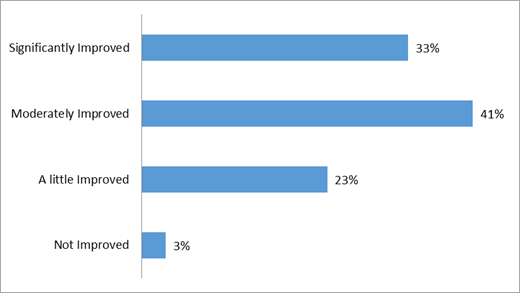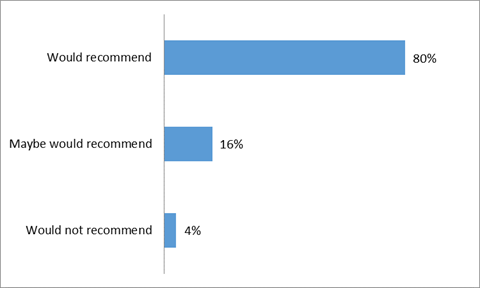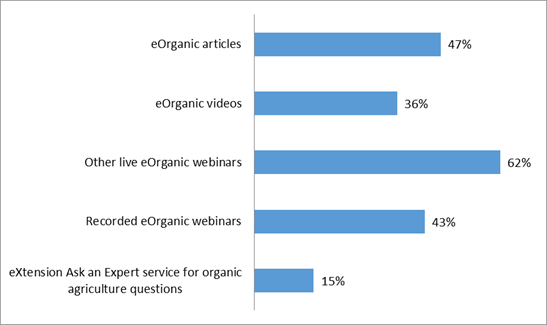 |
August 2014
|
August 2014 // Volume 52 // Number 4 // Feature // v52-4a5
Evaluation of the eOrganic Webinar Program
Abstract
eOrganic evaluated webinars on organic agriculture topics to assess the size and composition of the audience, how attendees heard about webinars, webinar quality and utility, whether participants use other eOrganic resources, and the impact on farmer and advisory practices. Results showed that eOrganic webinars reached their target audience. An average of 97% of respondents indicated that the webinars improved their understanding of the topics to some degree, and 96% intended to apply information to their work to some degree. Follow-up surveys on a subset of webinars revealed that they influenced changes in farming and advisory practices.
Introduction
Webinars are increasingly popular educational tools used by eXtension Communities of Practice, land-grant university faculty and other Extension professionals to engage stakeholders. Webinars can reach audiences in a convenient and cost-effective way (Rich et al., 2011; Allred & Smallidge, 2010), and they facilitate the flow of research information to educators (Futris, Adler-Baeder, & Dean, 2004).
The Organic Agriculture Community of Practice (eOrganic) offered 91 webinars related to organic agricultural science, practice, and regulation between December 2009 and March 2013. eOrganic uses GoToWebinar® software to host webinars and provide live broadcasts from in-person conferences. All webinars and broadcasts are recorded and archived at eXtension.org (http://www.extension.org/pages/25242) and on the eOrganic YouTube channel (http://www.youtube.com/user/eOrganic). eOrganic's target audience includes organic and transitional farmers as well as researchers, Extension educators, and other agricultural professionals supporting organic farmers.
This article describes the first 4 years of an ongoing webinar evaluation program and summarize its findings and implications for eOrganic and eXtension.
The goals of the eOrganic evaluation program are to identify and evaluate:
- The size and composition of the webinar audience
- How attendees heard about the webinar
- Webinar quality and utility
- The use of eOrganic published resources by webinar participants
- Webinar impact on farmer and farmer advisor practices
Methods
The eOrganic webinar evaluation project collected data from the following sources.
- Attendance Reports. GoToWebinar® attendance reports generated by the software program after each webinar collected registration and attendance numbers, registrant profession and geographical location, and quick poll responses.
- Google and YouTube Analytics data. eOrganic compiles Google and YouTube analytics data to assess use of recorded and archived webinars and broadcasts.
- Post-webinar Surveys. InstantSurvey® surveys were distributed to all attendees following each webinar or broadcast. The surveys included the following questions along with demographic questions:
- How much did the webinar improve your understanding of the topic?
- Do you intend to apply the information to your work?
- Was the technical level of the webinar appropriate?
- Would you recommend the webinar to others?
- How did you learn about the webinar?
- The survey also included an open-ended question asking respondents to suggest future webinar topics and describe how the overall webinar experience could be improved.
- Quick Poll Questions: Polls were conducted during 15 eOrganic dairy production webinars, asking participants whether the webinars improved their understanding of the topic and whether they planned to apply the information. The mean response rate was 81%.
- Follow-up Impact Surveys. Nine to 16 months (at least one production season) following selected webinars, impact surveys were sent to participants. These surveys contained topic-specific, multiple-choice questions about how participants changed specific farming or advisory practices as a result of attending the webinars. In 2011, follow-up surveys were sent to participants in a random selection of webinars. Responses to these surveys revealed that follow-up surveys only yielded useful responses if the goal of the webinar was to make recommendations that could be implemented by farmers. Therefore, in 2012, surveys were sent only to participants in webinars that contained such recommendations. The mean response rate for all follow-up surveys was 32%. All survey instruments and protocols were approved by the Oregon State University Institutional Review Board (IRB).
Results
Size and Composition of the Webinar Audience
Registrants for all 91 webinars as determined by GoToWebinar® attendance reports totaled 17,620. Attendees (people who actually attend the live webinar) totaled 10,534 (60% of registrants). Sixty-six percent of attendees participated in one webinar, while 34% attended multiple webinars. The average number of webinar attendees was 112 (range: 22-271), and the average number of conference broadcast attendees was 162 (range: 30-376).
The mean response rate to post-webinar surveys from 71 webinars (December 2010 to March 2013) was 61%. Respondents categorized their professions and locations (Figure1).
Figure 1.
Professions of 5,339 Respondents to 71 Post-Webinar Surveys (Percentages do not total 100% due to rounding.)

The distribution of professions in the post-webinar surveys was similar to the distribution of professions for the registrants who attended the live webinar. Attendees were required to list their professions when they registered for the webinars, and these numbers are reported in the GoToWebinar® attendance reports. The attendance reports for these same 71 webinars showed that 28% were farmers, 12% were Extension personnel, 11% were university researchers or educators, 22% were agriculture professionals, and 27% were others. Nonprofit staff was not included as a category in the attendee reports. Nevertheless, the professions of post-webinar survey participants reflect the general distribution of professions among webinar attendees.
Attendance reports documented webinar participation from all 50 states as well as all Canadian provinces and territories, and Puerto Rico, as well as 20 other countries. Post-webinar survey data documented participation by region of the United States: 30% Northeast, 24% Central, 11% South, 20% West, and 14% "other" (including multiple regions, regions with different names, and other countries).
According to Google Analytics, the page on eXtension that lists upcoming and archived eOrganic webinars at http://www.extension.org/pages/25242 was one of the five most-viewed eOrganic pages at eXtension.org from October 2012 to March 2013, averaging 1,608 views per month. As of March 2013, eOrganic's 91 archived webinar recordings were viewed more than 100,000 times on eOrganic's YouTube channel. The channel (which also contains videos) has over 2,000 subscribers and over one million total webinar and video views. YouTube analytics data from eOrganic's top three webinar recordings suggest that viewers are predominately male (66%), and more than 50% are 45-64 years old. Seventeen percent of viewers watched the webinars on mobile devices.
Example: YouTube Analytics data retrieved in August 2013 for the Grafting for Disease Management in Organic Vegetable Production webinar (Louws & Rivard, 2011):
- Total number of views: 9005; 3966 from the United States
- Viewer location: 147 countries
- Average view duration: over 5 minutes in 21 countries; 8:34 minutes in the U.S. (view duration data only available starting September 2012)
- Viewer age and gender: 80% male; 46% 55-64 years old, 30% 45-54, 10% over 65, 10% 35-44, 3% under 34
- Viewing device: 89% of views from computers and 11% from mobile devices
How Attendees Learned About Webinars
Most attendees learned about the webinars from eOrganic newsletter announcements or from a colleague, followed by eXtension.org and other websites (Figure 2). Social networks attracted only a small percentage of attendees.
Figure 2.
Responses of 5,339 Attendees to 71 Post-Webinar Surveys to the Question, "How did you learn about this eOrganic webinar?"

Webinar Quality and Utility
Post-webinar survey results from 71 webinars from December 2010 to March 2013 are shown in Figures 3-7.
Figure 3.
Knowledge Gained Averaged Across 71 Webinars. Responses to the Question "How much did the webinar improve your understanding of the topic?"

Figure 4.
Participants' Intent to Apply Knowledge Gained Averaged Across 71 Webinars. Responses to the Question "Do you plan to apply the information gained in this webinar to your work?" (Percentages do not total 100% due to rounding.)

Figure 5.
Attendee Perception of Technical Level of the Webinars Averaged Across 71 Webinars. Responses to the Question "Was the information presented too technical, too basic, or just right?" (Percentages do not total 100% due to rounding.)

Figure 6.
Ease of Access to the Webinars Averaged Across 71 Webinars. Attendee Responses to the Question "How easy was it for you to access and view this webinar?"

Figure 7.
Recommendation of Webinar to Others Averaged Across 71 Webinars. Attendee Responses to the Question "Would you recommend this webinar to others?"

In addition, the eOrganic Dairy team conducted quick polls in 15 dairy webinars (1,381 attendees: 385 farmers and 996 agricultural service providers and others). The results revealed that 81% of the attendees increased their understanding of the topics covered and 70% would implement what they learned on their farms or in their work with farmers.
In the open-ended question of the post-webinar surveys, respondents suggested ways to improve both the webinar process and content. While we did not formally tally these responses, we read them for feedback and ideas. In 2010, more than five participants suggested that eOrganic provide a copy of the slides in advance of the presentation, and this practice was subsequently implemented for most webinars with the permission of presenters. Some respondents requested a chat box so that attendees could communicate with one another. Others requested a live video of the speaker. At least two respondents requested that researchers include a farmer co-presenter so that attendees could learn from his or her experience. Several respondents stated that descriptions of organic farming research without practical recommendations are not useful for farmer audiences.
Survey respondents made many positive comments about the webinars. Some appreciated the access to science-based organic farming information, and others mentioned that webinars were a way to learn without leaving the farm or incurring travel costs. Some examples include the following.
- "eOrganic provides an invaluable service. I have worked in this field for many years in federal government, land grant system and non-profit world. Great to have cutting edge research like this available straight from the experts."
- "I have enjoyed all the webinars that I've listened to. I will continue to join in and believe these are important for …educating ourselves on the science of … our farming practices. This way we can educate others on the importance of alternative methods of farming. Thanks."
- "I appreciated you providing access to the presentations from the Organic Fruit Symposium for those of us who were not able to attend in person."
- "Really enjoyed this webinar. It fit right into the research we did last year…We were familiar with many of the issues involved but it is instructive to actually see photos and hear people with a lot more experience."
- "What I liked best about this program...and a couple of others I've seen...is good visuals that help the audience see what the presenter actually did or how they did it. The presenters have been very knowledgeable in their subject matter and are capable of answering important follow-up questions from the audience."
Other participants noted that webinars inspired them to make changes on their farms.
- "Great webinar... I am now motivated to take some of what I learned and try some trials on my livestock farm."
- "Though I planned to try this, the webinar has given me the info/confidence I need to start right away. I have some grain soaking now."
- "I really love your webinars. They are the perfect way to learn. I don't have to take time off the farm to travel, if the information is not applicable, I can leave, and the topics are pertinent. Today was perfect—a cold, rainy day here and I got to come in for an hour and a half, have a cup of coffee, and watch the webinar. Right after the webinar on pastures, I was inspired to head back out and make some changes to my grazing system. Thanks for inspiring and informing me!"
Use of Other eOrganic Resources by Webinar Participants
Post-webinar survey data reported respondent use of other eOrganic resources available on eXtension.org, including articles, videos, other live webinars, recorded webinars, and the Ask an Expert service (Figure 8).
Figure 8.
Percentage of Post-Webinar Survey Respondents Who Tried Other eOrganic Resources Averaged Across 71 Webinars

One hundred percent of respondents who accessed eOrganic articles, videos, and other webinars reported that they found them helpful to some degree; 96% found Ask an Expert helpful to some degree. On average, 51% of respondents found other eOrganic resources "very helpful," ranging from 40% for Ask an Expert to 59% for recorded webinars. From 2010 to 2013, use of eOrganic articles among webinar participants increased by 8%, use of videos increased 18%, use of other live webinars increased 14%, use of recorded webinars increased 22%, and use of Ask an Expert increased 8%.
Webinar Impact
Follow-up surveys sent to participants in 17 webinars in 2011 and 2012 demonstrated that an average of 89% of respondents said they applied the information in the webinar to some degree: 15% applied it "a lot," 47% "somewhat," and 27% "a little." Sixty-three percent of the 234 farmer/producer respondents said they changed specific practices; 288 respondents said they changed ways in which they advised farmers as a result of the webinar.
Example: Impact of the Grafting for Disease Management in Organic Vegetable Production webinar (Louws & Rivard, 2011).
Out of 86 respondents to the survey, including 39 who identified themselves as farmers, 84% said they applied the knowledge to their work to some degree, and 80% of farmers and producers (including some gardeners) said the webinar had contributed to a change in their farming practices.
47 webinar attendees responded to a question directed to farmers and producers that asked if they did any of the following as result of the webinar:
- 21 (44%) grafted tomatoes on their farm
- 34 (71%) learned how to graft tomatoes
- 26 (54%) purchased grafting supplies
- 17 (35%) installed a heating chamber
- 10 (21%) experienced greater yields as a result of grafting
- 10 (21%) increased profits as a result of grafting
- 4 (8%) grafted other vegetable crops than tomatoes
33 of 39 farmer advisors provided information on the following as a result of the webinar:
- 25 (71%) provided information on the benefits of grafting
- 24 (69%) provided information on how to graft tomatoes
- 21 (60%) provided information on supplies needed for grafting
- 16 (46%) provided information on how to find rootstocks for grafting
- 15 (43%) provided information on how to find grafting supplies
Discussion
Size and Composition of the Webinar Audience
As demonstrated by the webinar attendee data, eOrganic was successful in reaching its target audiences of farmers, Extension educators, agriculture professionals, university researchers, and organic certification professionals, along with some Master Gardeners and students. Many of these people were also using other eOrganic published resources. eOrganic is reaching considerably more people through its archived webinars, although it is not possible to document the professions of the viewers and the impact of their viewing of the webinar on their knowledge or practices.
Farmers comprised 27% of the live webinar audience on average, with a range from 4% to 54%. Initially, it was thought that farmers would not access videos or other Web-based resources. However, farm access to and use of high-speed Internet has increased rapidly in the past decade. According to the 2013 NASS survey of Farm Computer Usage and Ownership, 67% of US farms now have Internet access, and at least 89% of those have DSL, cable, satellite, or wireless connections. Only 5% of farmers with access have dialup, down from 12% in 2011 (U.S. Department of Agriculture, 2013). As early as 2004, the Organic Farming Research Foundation's Organic Farmers' Survey found that 78% of organic farmer respondents had Internet access (Walz, 2004). The more recent Farm Activities Associated with Rural Development report said that 86.5% of organic farmers had Internet access, and 61.5% of organic farmers had access to high-speed Internet (Bagi & Reeder, 2012). So, while not all farmers have high-speed Internet, many do, and this data suggests that webinars can be utilized by many farmers.
The fact that 61% of the webinar audience heard about the webinars directly through eOrganic email newsletters (Figure2) followed by a friend or colleague at 16%, likely forwarding an email about the webinar, suggests that the email list is the most effective way of attracting webinar attendees. In contrast, our social networking activity, while maintaining an established follower base (over 2,000 Facebook "likes" and over 2,000 Twitter followers), generates only 1% of webinar attendees. One post-webinar survey respondent suggested posting our announcements on more university and organic agriculture listservs as a way of attracting a larger audience.
Use of Other eOrganic Resources by Webinar Survey Respondents
When the webinar program began, relatively few participants had tried other resources created by eOrganic on eXtension; however, use of these resources has increased between 2010 and 2013. It is possible that webinars help attract new audiences to other eOrganic/eXtension resources. Increased linking to related resources on webinar registration and archive pages could also be an effective way to increase usage of other eOrganic/eXtension resources.
Webinar Quality, Utility, and Impact
Overall, respondents to the post-webinar surveys indicated that eOrganic webinars were informative and contained applicable information, were presented at an appropriate technical level, and were easy to access.
Farmers attended organic research webinars, but farmers did not always find research webinars useful. Survey respondents suggested that webinar presenters should provide practical recommendations based on the research and that farmer collaborators should be included as presenters when possible. If a webinar will be focused on research methodology and results (rather than recommendations), it should be marketed specifically to researchers rather than to a mixed audience.
As a result of the surveys, eOrganic has tried to minimize the number of attendees who have found it difficult to access the webinar or the sound. Sound checks are conducted with all presenters and conference venues in advance. In webinar announcements, information on how to update Java and how to test the connection in advance is provided. Instructions on how to connect by phone are described on the first slide attendees see when they connect to the webinar so they can access the webinar audio by phone if their computer audio isn't working.
Feedback from follow-up surveys indicated that eOrganic webinars affected some changes in farm practices and in recommendations given to farmers by agricultural professionals. In future surveys, a question related to the monetary value of the changes implemented by farmers and advisors will be included. Webinar recordings have and will also be used in online and hybrid courses such as the eOrganic Organic Dairy Production Course, which should further increase their reach.
Conclusion
eOrganic webinars conveyed science-, experience-, and regulation-based information to eOrganic's target audience of farmers, researchers, Extension educators, and agricultural service providers. They increased knowledge and affected changes in farming and advisory practices. Continued work is needed to improve and refine the webinar experience for attendees. Staff will continue to identify technical advances to make the webinar format more engaging, work with researchers to help them present their data appropriately for mixed audiences, and market webinars on specialized topics to appropriate groups. Webinars can be used to make participants aware of other related and useful resources. More work is needed to expand eOrganic's webinar audience, possibly through postings to additional mailing lists and active social networks, as well as through use in eOrganic online courses. eOrganic plans to continue the webinar program in the future. Find upcoming and archived eOrganic webinars at http://www.extension.org/pages/25242.
References
Allred, S. B., & Smallidge, P. J. (2010). An educational evaluation of web-based forestry education. Journal of Extension [On-line]. 48(6) Article 6FEA2. Available at: http://www.joe.org/joe/2010december/a2.php
Bagi. F.S., & Reeder, R. (2012). Farm activities associated with rural development initiatives. U.S. Department of Agriculture Economic Research Report No. ERR-134. 48 pp, May 2012. Retrieved from: http://www.ers.usda.gov/ersDownloadHandler.ashx?file=/media/601606/err134_1_.pdf
Futris, T. G., Adler-Baeder, F., & Dean, K. J. (2004). Using technology to link researchers and educators: Evaluation of electronic conferencing. Journal of Extension [On-line], 42(1) Article 1RIB1. Available at: http://www.joe.org/joe/2004february/rb1.php
Louws, F. & Rivard, C. (2011). Grafting for disease management in organic tomato production webinar. Retrieved from: http://www.extension.org/pages/32969
U.S. Department of Agriculture National Agricultural Statistics Service. (2013). Farm computer usage and ownership. Retrieved from: http://www.nass.usda.gov/Publications/Todays_Reports/reports/fmpc0813.pdf
Rich, S. R., Komar, S., Schilling, B., Tomas, S. R., Carleo, J., & Colucci, S.J . (2011). Meeting Extension programming needs with technology: A case study of agritourism webinars. Journal of Extension [On-line], 49(6) Article 6FEA4. Available at: http://www.joe.org/joe/2011december/a4.php
Walz, E. (2004). Fourth national organic farmers' survey: Sustaining organic farms in a changing organic marketplace. Santa Cruz, CA. Organic Farming Research Foundation. Retrieved from: http://ofrf.org/publications/survey.html




